Best 2021 OLED TV showdown: LG G1 Gallery vs Sony A90J Master Series
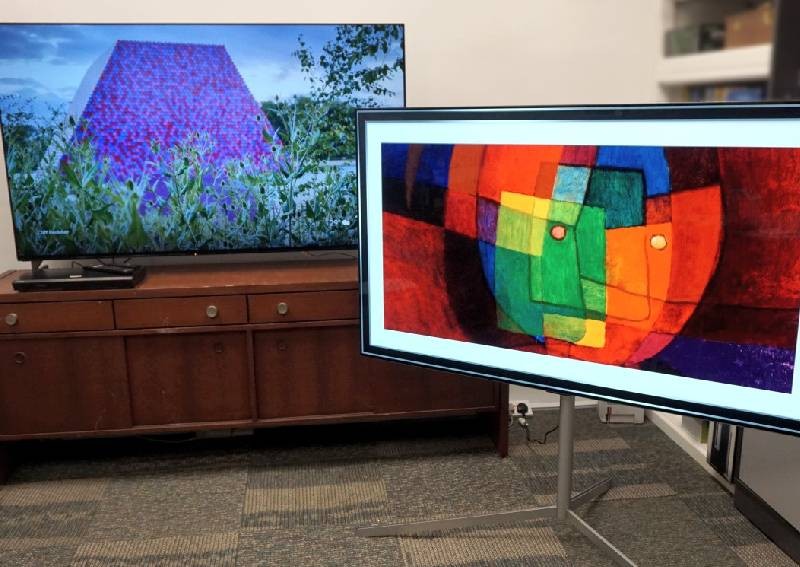

Tech enthusiasts will know that both the LG G1 Gallery OLED Evo and Sony Bravia XR A90J Master Series models are the very best OLED TVs in the market, but they'll also be quick to point out that these were launched in mid-2021. So why are we visiting this topic at a juncture when new models will be out soon?
First off, TVs, like mobile phones, get several firmware and software updates over time, and these soft advancements are getting ever more crucial to dictate your TV's abilities. Let's take a quick look at what advancements both these models gained since their launch:
As you can see, the listed updates are just a quick snapshot to give you an idea of the rapid state of feature support advancement via firmware and app updates where both LG and Sony whip up gains.
However, in my opinion, the most important of them is Sony's variable refresh rate (VRR) support that finally gives gamers a smooth, tear-free gaming experience without sudden dips and frame skips that might otherwise rob you of crucial moments in your gameplay when connecting your PC or Xbox Series X/S to the TV.
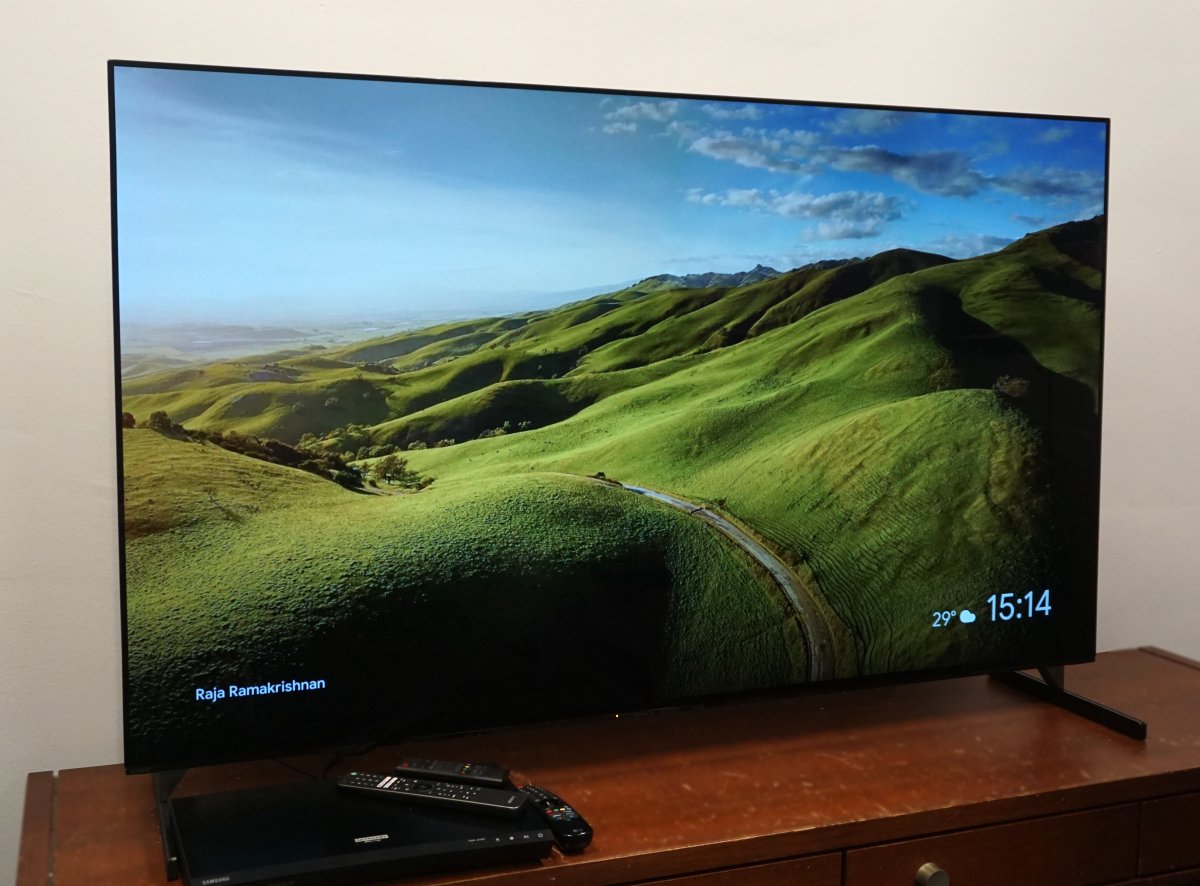
This was missing from the TV since it was launched nearly a year back, while LG's TVs have supported the full HDMI 2.1 feature functionality since the start. Had it not been for Sony's latest firmware update that's just weeks old, this LG vs. Sony comparison would have been a non-starter as you'll soon find out how closely match both TVs are.
Without a possible comparison chance, we wouldn't even have the Best OLED TV category contention in our Editor's Choice segment of Tech Awards 2022. So perhaps, we've Sony to thank, albeit late in the game? Let's find out by digesting their official price points:
| Size | LG G1 Gallery OLED | Sony A90J Master |
|---|---|---|
| 55-inch | $4,599 | $5,999 |
| 65-inch | $6,299 | $8,999 |
| 77-inch | $12,999 | N.A. |
Before we begin, it would be useful to be familiar with what we've already covered so that we can skip covering those aspects in this article.
Here's our video on what's new with the LG G1 Gallery TV and what you need to know about the Sony Bravia XR TV series and its XR Cognitive Processor.
It will also be useful to keep tabs on what the previous-gen TVs (the LG CX and Sony A8H) offer to better understand the improvements on the 2021 models, which are still the leading options at the time of publishing.
First impressions count, so let's briefly check out how both TVs fare in the design and build department. We've covered a fair bit of the LG G1's overall design, build, default flush wall-mounting capability and the optional Gallery stand in our previous video at this segment:
[embed]https://youtu.be/m-gAZCYnktw[/embed]
In comparison, the Sony A90J Master Series oozes a tad more understated sophistication and elegance with its ultra-thin bezels, finished with its well-known branding at one of its corners.
While the Sony A90J comes with TV feet by default, they have a smart design to them where they can be angled out to have the TV screen sit flush against the base of your TV console, or it can be fixed in a raised position to accommodate a soundbar below it. As such, the A90J is also more versatile, design-wise.
Ironically, this TV boasts an impressive audio delivery system that negates a soundbar investment unless you require very strong sonic performance. Speaking of which, its rear cabinet isn't a lot thicker to accommodate its integrated sound system, yet it appears classier than the LG from even its rear, thanks to the functional aluminium heatsink backing.
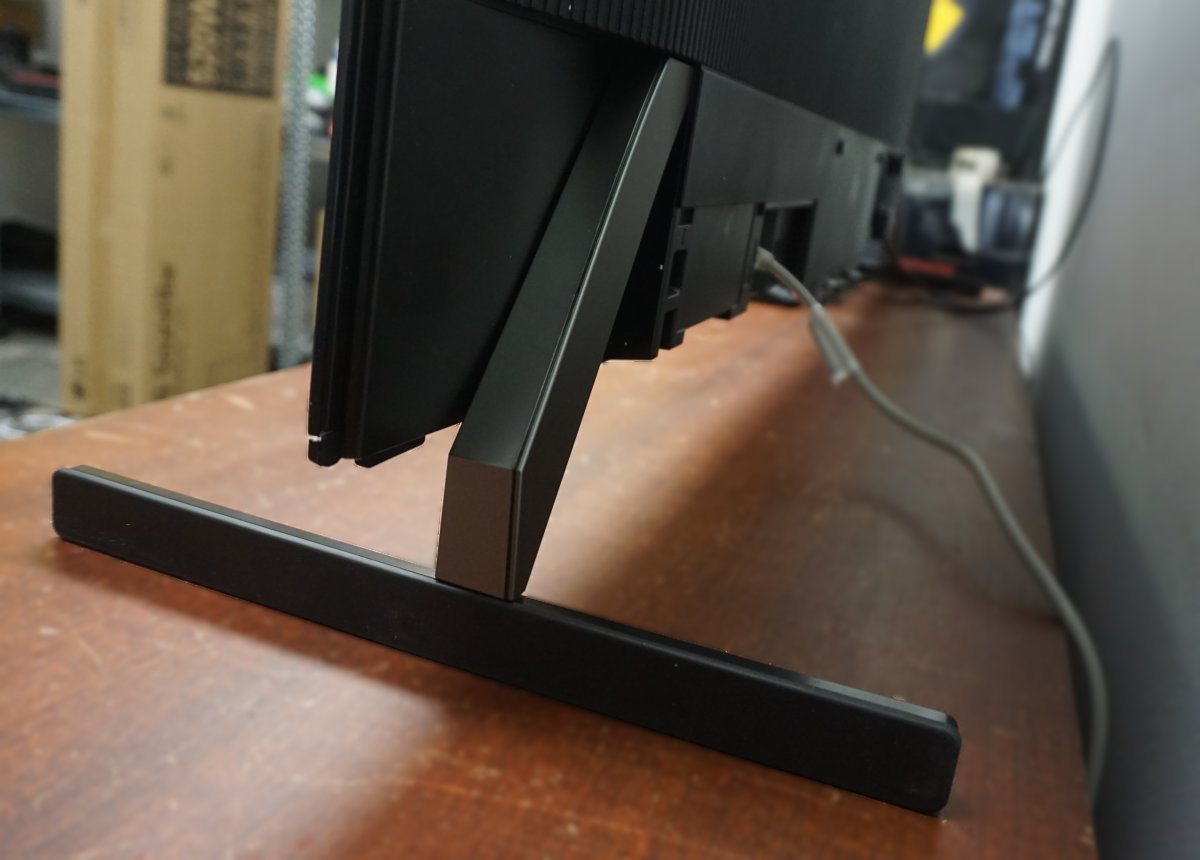
Ports and accessibility are expectedly in their usual placements, where the USB ports and one HDMI port are slightly recessed on the left side of the Sony A90J, whereas most of the HDMI ports are facing down and are further behind.
Changing gears to gaming, this is a domain that LG is fiercely guarding and is leading the field. The G1 (as well as the C1 and B1 series) is still the only TV that offers quad HDMI 2.1-compliant ports, which means they support 4K gaming at 120Hz with variable refresher rate (VRR) support on all of them.
If you have a few gaming consoles/systems and an external audio subsystem, you don't have to pick and choose who gets to use the HDMI 2.1 port for the best gaming experiences on the Xbox Series X, the Playstation 5 (eventually), and even on your gaming PC connected to the big screen.
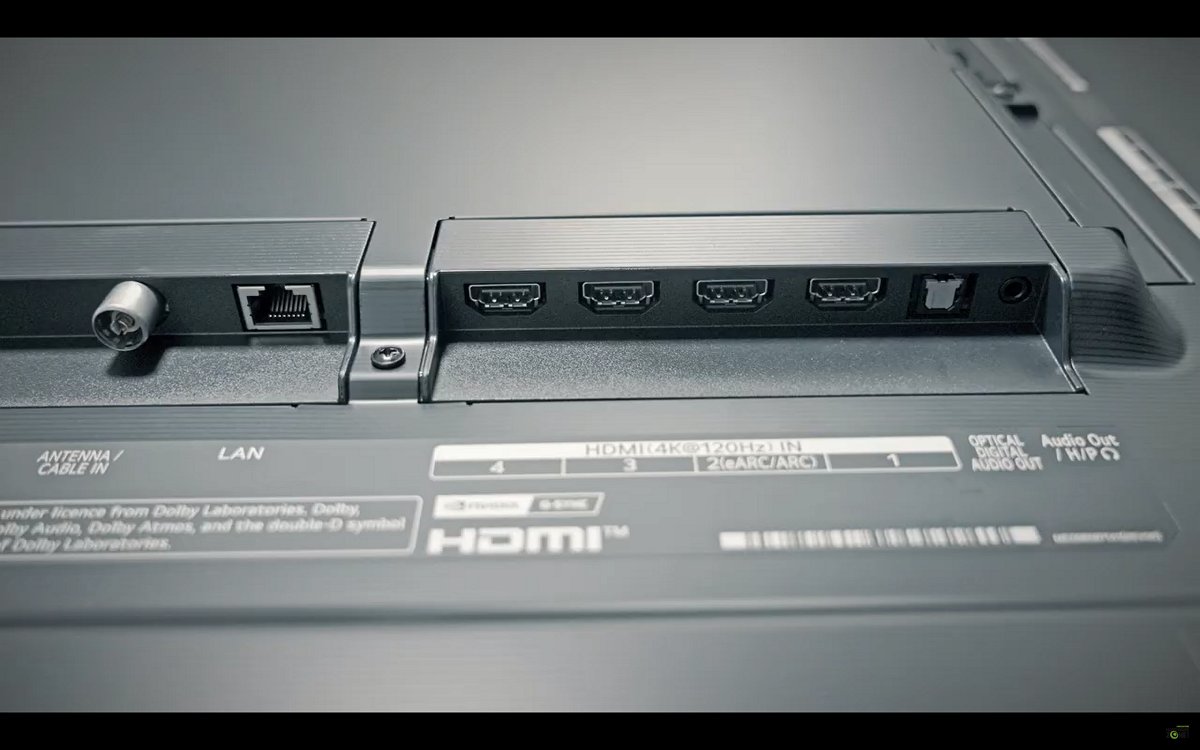
LG is also the only TV brand consistently featured on NVIDIA's G-Sync compatible list, supports the AMD Freesync Premium tier, plus it's also the only screen to support Dolby Vision HDR gaming on 4K 120Hz with supported gaming titles, which is a considerable feat. Let's not forget the Game Dashboard where you can dial up features and makes adjustments while you're in-game.
Over on Sony's top TV, only two of the quad HDMI HDCP 2.3 ports support the full HDMI 2.1 spec, meaning if you use an external sound system to pipe audio from your streamed shows on Netflix, you're only left with one other HDMI 2.1 port to be shared among your high-end gaming consoles/systems.
The other two HDMI ports comply with HDMI 2.0 specs, which means they will support up to 4K 60Hz inputs - more than enough for casual needs, but not for gamers who have the latest consoles and/or gaming PCs capable of high refresh rate, high resolution gaming and are all vying for the limited port options.
Clearly, LG is the best TV for gamers at this juncture.
The unassuming remotes play a much bigger role than most of us would care to admit, but it's clearly your gateway to operate the TV, despite the fact both LG and Sony TVs can be operated via your phone when paired appropriately with the right apps. So what's there to pick about?
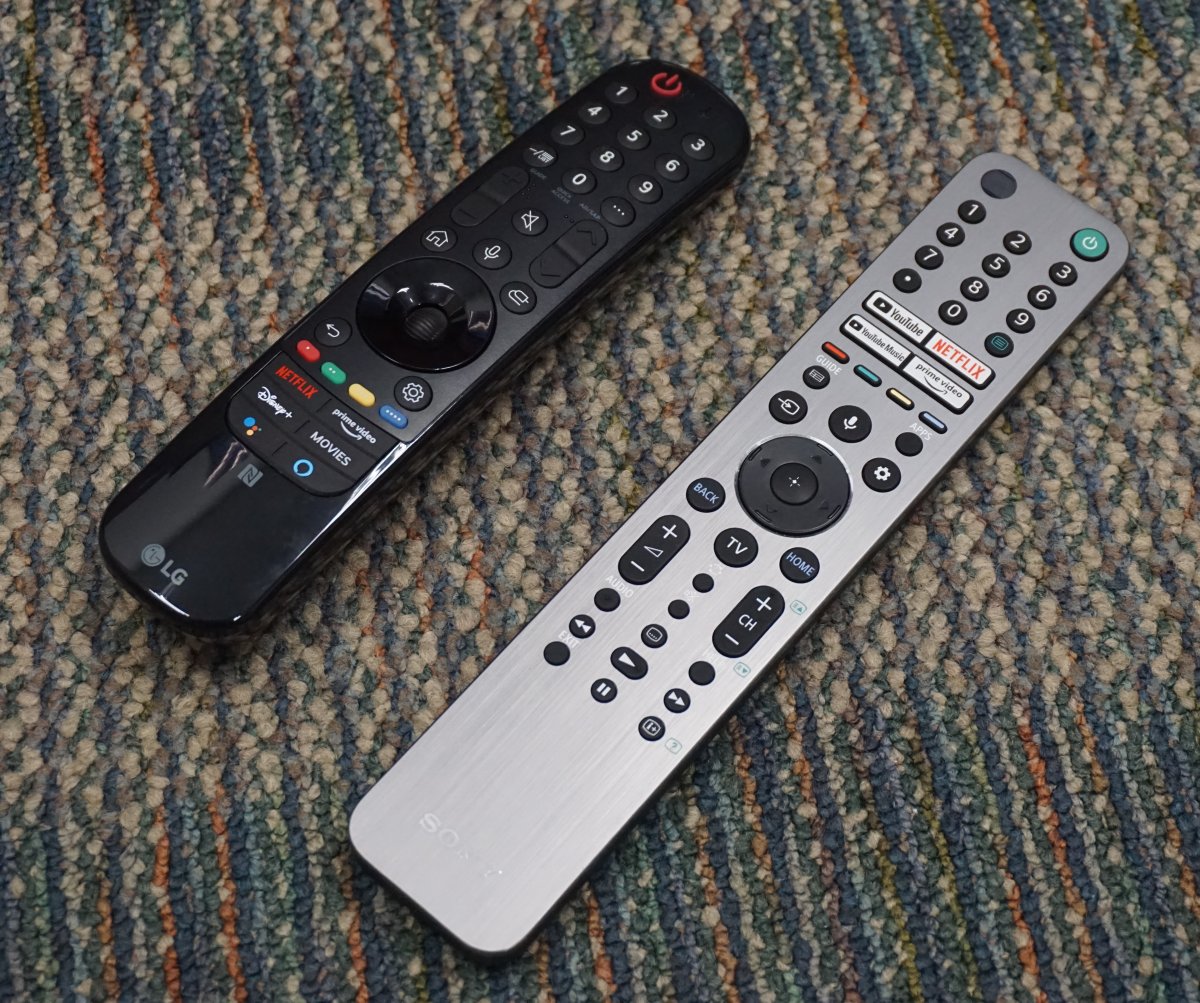
Let's start with LG's newly revamped remote that's slimmer, sleeker and has more tactile buttons that you could mostly activate from muscle memory. It also sits very comfortably in hand and offers shortcut buttons to all three popular video streaming channels in Singapore: Amazon, Disney+, and Netflix.
Voice-control functionality with Google Assistant or Alexa assistant is also a button press away. And not to forget, LG's claim to fame in TV UX matters is thanks to their Magic Remote functionality, whereby the remote acts as your mouse pointer in an instant to navigate TV interface options and even web surfing without a concern. Check out all these features in action via my video overview at this segment:
[embed]https://youtu.be/m-gAZCYnktw[/embed]
There are only two things to nitpick. It still doesn't offer back-lit buttons for easier dark room usage, nor does it have direct media control buttons, which depending on the video player or streaming service used, would require additional button presses to gain the required controls.
Now Sony's remote for the A90J Master Series actually offers these two aspects that are missing from LG's remote. Direct media controls are quite a boon with immediate forward/rewind options at hand rather than invoking the player's controls before activating the desired function. But this comes at a cost.
The remote is unnecessarily long and slender, and some of the non-important buttons are uncomfortably small to engage. Plus, the main navigation pad doesn't feel as good as Sony's older remotes.
[[nid:573405]]
It's also missing the quick action button to activate frequently used settings/options such as blanking the TV's screen, which is useful when using the screen as the main audio driver in your home. Just launch your favourite Spotify playlist and turn off the screen while the TV still remains operational and blasting your tunes.
They are more difficult to get to on the newer Google TV interface, coupled with the newer settings layout. I'm also not so sure how many would appreciate a YouTube Music shortcut button on the remote over having a Disney+ button, but I prefer the latter to be at hand.
The other saving grace is that the remote has motion and ambient sensor-based backlit-controlled keys that light up as soon as you pick up the remote in the dark, which is quite cool.
As cool as it looks and functions, LG is still the better contender for a user-friendly remote that has better overall form and functionality.
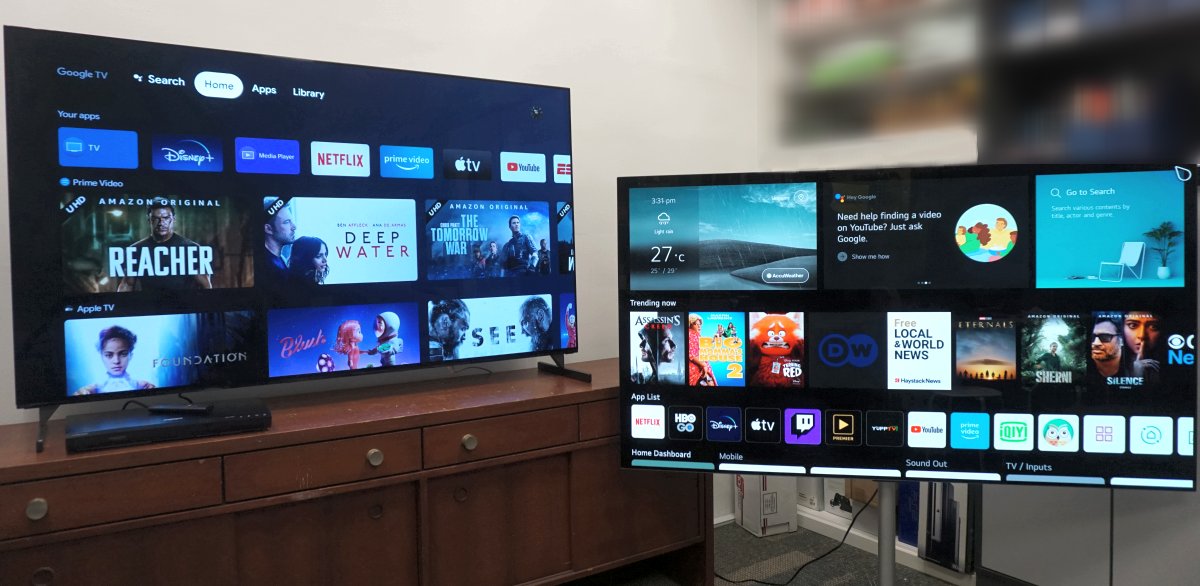
What about from a TV usability perspective? Even though Sony's Google TV has had a makeover, LG's webOS 6 still trumps the Japanese counterpart.
From having a central pool of movie and show recommendations across different video streaming options, to having quick access to your connected smart home appliances and even jumping to a preferred input device, LG's new home screen field more integrated, smarter and more accessible.
Let's not forget LG's revamped remote that's so friendly to use in conventional mode, or via its magic wand feature. The immediate usability is simply better than Sony's attempt. Here's a photo reel of LG's webOS from its home screen:
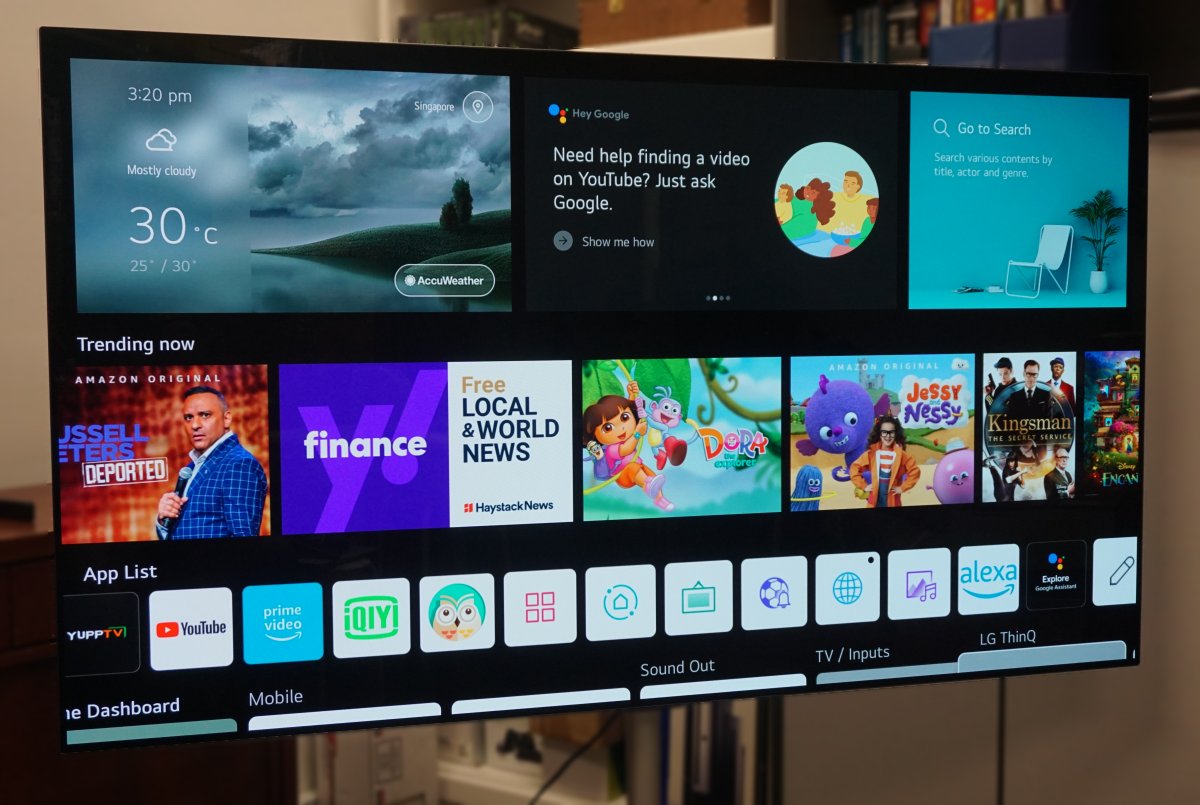
Sony's Google TV UI isn't bad, but its a very mild superficial update over older Sony Android TVs and it still doesn't avoid having two different settings sections where one is related to your Google Account, while other other pertains to the TV settings. As such, it still feels disjointed, albeit with a slightly slicker interface than Sony's older TVs.
Where Sony can trump LG is in the TV's app ecosystem department, where there are simply many more Android apps available at your disposal and are an easy way to engage kids with simple games over a paired gaming controller. So that's the power of a Google TV-based ecosystem, but it's a choice you would have to live with for the rest of the TV's lifespan.
Do you mind having an average UI experience (but gain a big app store) or one that's more intuitive day in and out? This could very well be a key deciding factor than performance-based inclinations.
We'll go with LG on this one for forging ahead on their own path and helping evolve the TV UI and UX experience positively for better everyday interactions. After all, mobile screen mirroring accords you an easy way to quickly push your game on the big screen occasionally.
Alternatively, Android boxes are available that allows you to do the same via the TV if you're serious on Android gaming, so there are options to LG's limited webOS ecosystem.
Extending a little more on the TV functionality and UI, we thought of touching on LG's Art Gallery mode, which offers artworks and photography that are stored and streamed from LG's servers.
[[nid:574603]]
The LG G1 is, after all, a Gallery Design TV series, and its super thin bezels combined with the flushed wall mounting capability makes it a prime option to display art when it's not busy entertaining you.
Better yet, if you've opted for the Gallery Stand add-on (as seen in our setup), the picturesque art stands out even better. With a convincing 'frame' that adds depth, texture and shading, it adds yet another dimension to the selected artworks.
However, the selection of artworks and customisations to keep it going as a giant art/photo slideshow is limited compared to Samsung's Frame TV series, though that's further augmented by a subscription service to unlock more than what Samsung throws in by default.
What about Sony's A90J Master Series? While the TV defaults to fetching random photography from Google as part of its screen saver functionality, there's not much else similar to LG or Samsung for an art mode feature. However, you can rely on the Google Play Store to help you hone in on something that might fit your taste.
One variant is actually pre-loaded by default and is a Sony exclusive app called the Living Decor. Dubbed a 'sensorial gateway', Living Decor turns your TV into an essential part of your living space, with carefully selected images and music themes, photo frame and clock functionality.
It isn't an 'art mode', but it is a fancy way to display a highly curated set of imagery or have the app pull images from your Google Photos account.
Like other TVs we've tested in the past, we disabled several settings that could potentially interfere with screen testing the TV's native handling and capabilities. The LG TV was tested using the Filmmaker mode that turns off most processing to keep to the creator's intent where this option was available. Alternatively, we also utilised ISF Expert (Dark Room) which was fairly close to the Filmmaker mode.
Similarly, we turned off other unnecessary processing options on the Sony A90J that could affect how we assess its panel's capabilities and leave the picture untouched as much as possible.
For example, we disabled settings like Auto Picture Mode and Light Sensor that could induce uncertainties in how the TV's output is processed and affect the outcome scene by scene.
For most people who use the TV both day and night, though, the embedded light sensor can be useful as it informs the TV of the current ambient light level, which allows it to optimise picture brightness on the fly. So you might want to keep that turned on for your convenience.
As can be expected, Cinema mode offers the most pleasing colours, and it's hard to go not go wrong by just selecting this mode for most of your viewing needs.
Regarding motion handling, we're purists and prefer to keep our shows as they are intended to be consumed such as movie content with 24p cadence and not having the TV smoothen things out (also known as the Soap Opera Effect).
As such, we disengaged LG's TruMotion option and turned off Sony's Motionflow options. For content with a lot of action, you might prefer to have Black Frame Insertion (BFI), but it also usually reduces the brightness, so only engage it if perhaps you're watching a football match or other fast-moving sporting events.
In LG's TVs, you'll find this feature called OLED Motion Pro and you can adjust the settings to taste. Meanwhile, on Sony, you'll find this option via the Clearness slider under Custom Motionflow settings.
Honestly, testing against the best of the best sometimes involves splitting hairs and nowhere did we feel it was as close as pitting two of the very best TVs money can buy.
Both LG and Sony utilise similarly new OLED panels that transmit more light than the usual crop of OLED TVs, with newer processors (LG's Alpha 9 Gen 4 AI processor and Sony's Cognitive Processor XR, respectively) backing the new displays for next-gen processing capabilities.
Both LG G1 and Sony A90J put up a brilliant performance show with marvellously deep inky blacks, fantastic contrast, and excellent expression of HDR highlights in Dolby Vision and HDR10 content. As a TV, you want the screen to excel well, and both score highly in this aspect.
Closer scrutiny would reveal that Sony's Cognitive XR processor's careful processing to consider how human vision perceives and reacts to content seems to have come through with colours and shades that tend to feel a tad more natural.
On the other hand, LG is no less competent, but it looks ever slightly more saturated, and as a result, a minor tendency to hide details as your eyes are more focused on the overall punchiness of the scene. Without a side-by-side comparison, you would be pleased with either set.

At other times, the only difference discernable is that LG seems to prefer a slightly warmer colour tone than Sony. Strictly speaking, this is treading the boundaries of personal preferences that are easily tweaked in custom colour options than using it as a basis for choosing one screen over another.
Plus, these minute differences are easily tweakable in the respective TV's colour control options to your preference. Both are stellar screens in rooms with little to no ambient lighting and is impossible to differentiate them apart without a controlled comparison like in our test lab.
A scene from The Mandalorian series on Disney+. This streaming show support Dolby Vision, so we're once again testing using the Dolby Vision Bright Room picture mode on both screens. On the left, we have the Sony A90J, and on the right, we have the LG G1. Note the very slight colour temperature difference between them? That's what sets them apart. They are identical otherwise.
There's very little to differentiate them, and anyone would be equally content with both options. Below, we fired up a 4K Blu-ray title that is Dolby Vision certified. Once again, we noticed LG being rendering the scene a tad more saturated in the reds, while the Sony appeared a tad brighter and more natural.


For the most part, we've not really encountered anything of concern, except for this one scene where Sony had a brighter rendition than LG.
While the same high shutter speed setting used to capture all the movie test shots made this scene appear darker than it really is in actual viewing, it's interesting to note the difference captured by the camera. However, we're really nitpicking at this juncture as you really can't tell when you're in the thick of watching a movie.
The above spiked our interest to see how both TVs might fare in a really bright room setting. After all, both these models boast the most capable OLED panels available on the market.
As we've come to know, OLED TVs are still no match for LED-backlit LCD models when viewing in a bright room or expressing bright content, and it showed in our quick trial. It wasn't until we engaged Vivid mode that both TVs appeared to cope well in a bright room, definitely something older OLED TVs would have trouble impressing upon you.
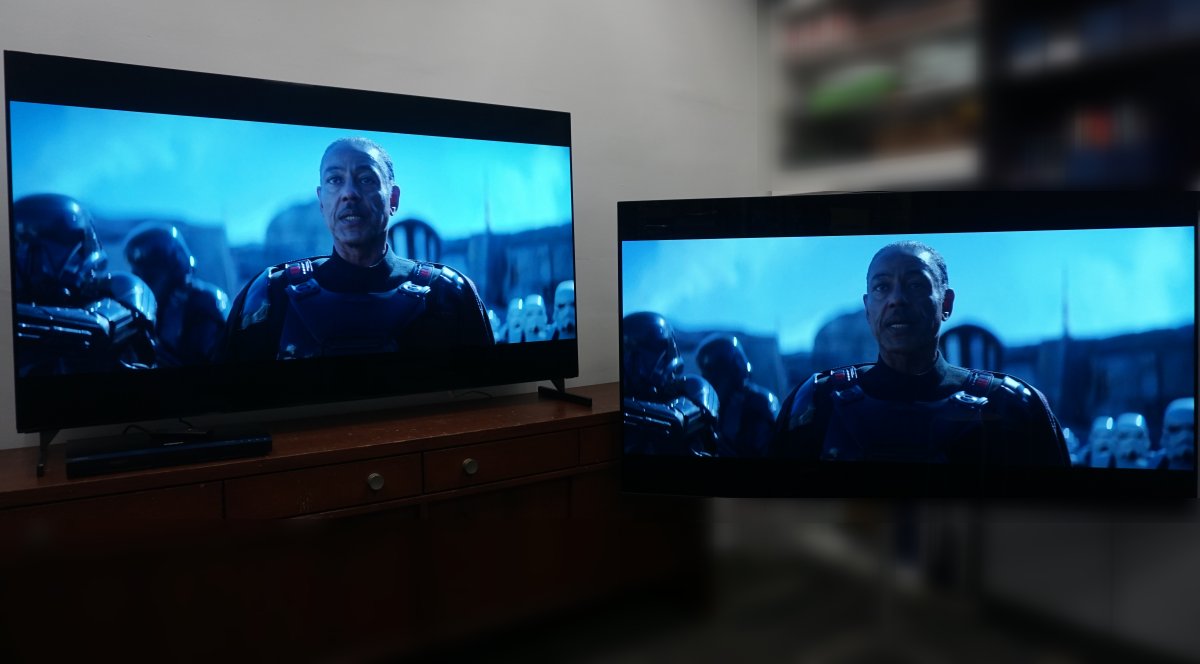
Once more, our camera captured the Sony A90J to be seen as the brighter and more capable screen in a room with plenty of direct lighting (the actual room lighting level is far brighter than seen in the shoot above). In actual viewing, while Sony is brighter, it wasn't to the same extent as the camera would lead you you to believe.

So there we have it, Sony and LG are quite evenly matched visually, most of the time.
Sonically, the Sony A90J Master is hands down the best you'll get to experience from a TV. The Acoustic Surface Audio+ has excellent audio delivery and presence and can even afford you some virtual surround sound through its 60W of audio power delivered via the entire screen, to you.
You can read more about our in-depth experience with Acoustic Surface Audio+ from an older model, but the principles and experience are very similar.
Even a Sony A8F from 2018 can still deliver a good showing over many other new TVs in the market, including the LG G1. So that's a testament to Sony's perfection of audio from screen experience.
Sony is also one of the few TVs that still incorporate a DTS encoder, and it's useful in the case where you don't intend to get an external sound system and only utilise the capabilities of the Sony A90J. Most streaming contents utilise Dolby Digital Plus so there's not much content encoded with DTS other than Blu-ray discs.
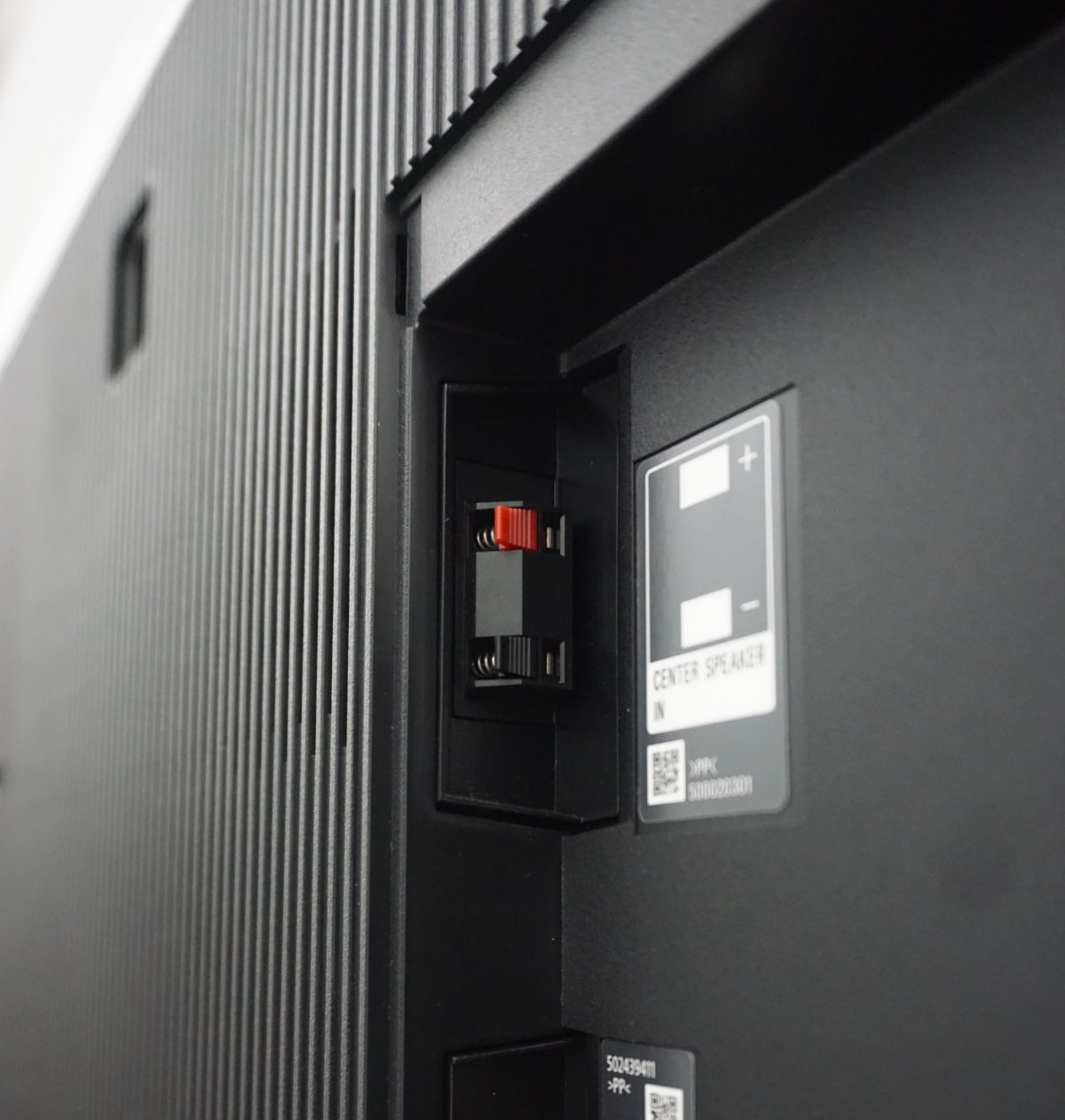
For those of you who've already invested in a hefty audio system or planning to go all out to outfit your home with multi-speaker audio system, you'll be glad to know that the Sony A90J even allows you to integrate its Acoustic Surface Audio+ as your sound system's centre-channel.
Dubbed the Center Speaker Mode, it does exactly that, turning your TV into a centre-channel speaker via the direct audio input terminal clips found at the back of the Sony A90J.
As we've experienced first-hand, dialogue and audio are delivered right from the screen, resulting in better vertical audio imaging. Dialogue no longer seems to emanate from below the screen where your traditional centre-channel speaker is normally placed.
[[nid:564015]]
The other advantage is good centre-channel speakers are usually quite obtrusive in size and presence, which the Sony A90J solves by eliminating them.
It's a nice feature, for some, though it can't outmatch the audio depth, details, and volume from a good standalone centre channel speaker. Plus, managing volume levels are a little trickier as the A90J would manage the audio level of its built-in speaker, while the rest of your home's sound system would have to be controlled via the AV Receiver.
The LG G1 however, sounds ordinary in comparison, even with its AI Sound Pro processing. While my video walkthrough has shared what AI Sound Pro processing can do when the stars align, there's not a lot of times when we see this being well utilised and is more of a bonus feature, just like the Center Speaker Mode on Sony, which is heavily caveated in usage applicability.
If you missed what this feature can do when it works right, I've bookmarked the audio test segment where I've tested it out:
[embed]https://youtu.be/m-gAZCYnktw[/embed]
The bigger question is if the Sony A90J Master is worth two grand more than the LG TV by virtue of its excellent built-in sound system. While value is debatable and having the best integrated experience is always a premium, the simple counter answer is the LG G1 with a stand-alone audio system worth two grand will sound tremendously better than the Sony A90J Master.
LG's 2021 TV models are also Bluetooth Surround Ready, whereby you can throw in just about any Bluetooth speakers you've at hand, pair them with the TV and set them up to the sides or rear of your sitting position to enjoy true surround sound with your TV's main speakers.
Now that's a quick and affordable fix for any show, anytime, without owning a multi-channel speaker system. The fidelity required by surround speakers are nowhere in the same ballpark as your left, centre and right audio channels. Instead, surround audio is usually better appreciated for having the right volume levels and accurate audio placement.
It's evident that LG is both practical and clever by incorporating such a feature that can be easily appreciated by the masses.
So here's how both TVs stack up in the performance arena for our various findings:
| Test | LG G1 Gallery OLED Evo | Sony A90J Master Series |
|---|---|---|
| Bright room | 8.5 | 9.0 |
| Dark room | 9.5 | 9.5 |
| Colour | 9.0 | 9.5 |
| 4K | 9.5 | 9.5 |
| HDR | 9.0 | 9.5 |
| Motion | 9.0 | 9.0 |
| Audio | 7.0 | 9.0 |
In summary, LG has many things right going for it that make it an easy choice for anyone wanting the best OLED TV model. It's got great performance, not overly expensive, yet has a better feature set appreciated by more people, better gaming features for hardcore gamers (which worked from the start), and a friendlier TV from a UI and UX perspective.
[[nid:575080]]
That's not to say we won't recommend the Sony A90J Master Series. It does, after all, have a tad brighter screen and a built-in sound system that's unbeatable by any other TV.
In fact, its sonic performance is so good, Sony has speaker posts integrated at its back to allow you to integrate the TV as part of your home theatre's centre-channel speaker.
This does mean the Sony A90J Master Series is really only for discerning folks who've deep pockets and appreciate either not having to buy a standalone soundbar or folks who already have a good sound system. Ironically, Sony seems to be catering to those with niche demands, and it accomplishes its mission in that respect.
In the end, LG's G1 Gallery OLED is an easier choice most can agree upon and has a winning combo to get our nod as the overall Best OLED TV recommendation. After all, you can actually get most of what the G1 series offers in even the C1 and B1 series, further making the LG OLED lineup an appealing option.
| Criteria/Model | LG G1 Gallery OLED Evo | Sony A90J Master Series |
|---|---|---|
| Design | 8.0 | 8.5 |
| Features | 9.0 | 8.5 |
| Performance | 9.0 | 9.5 |
| Value | 8.5 | 7 |
| Overall | 8.5 | 8.5 |
| Price (65-inch) | $6299 | $8999 |
| Awards | NIL |
This article was first published in Hardware Zone.